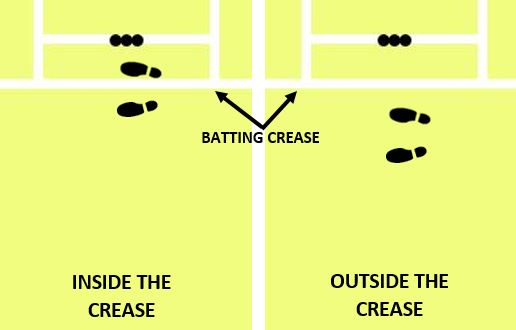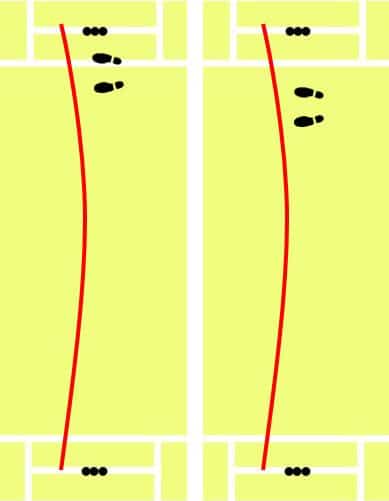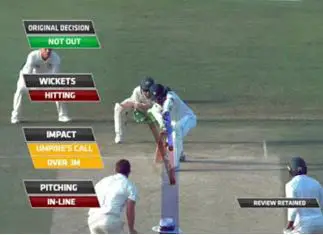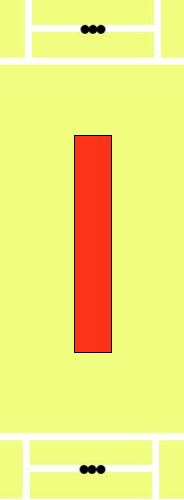The area on a cricket pitch known as ‘the crease’ is a safe haven for batsmen. As long as they have a part of their body or their bat grounded within the crease, they are safe from being stumped or run out. As a result, the majority of batsmen will choose to keep a part of their back foot within the crease when they’re in their batting stance. Not only does this position protect them against being stumped or run out by a crafty wicket keeper – it also keeps them a comfortable distance away from the bowler that gives them enough time to react to the ball.
However, not all batsmen set up this way! Sometimes you’ll see them set up in a completely different position, with both feet well outside the crease. If you’re wondering why a batsman may choose to do this, and what sort of advantages it offers them, then you’re in the right place! In this post I’ll take you through the ins and outs of why batsmen may choose to bat outside of the crease, including the pros and cons of doing so!
There are a few main reasons why batsmen will choose to bat outside of their crease. They are:
- To smother any lateral movement
- To disrupt the length of the bowler
- To take LBW dismissals out of the equation
- It allows you to play on the front foot more often
In the rest of this post I’ll dive into these in a bit more detail and explain how exactly batting outside your crease can help you achieve each of them. We’ll also look at how far down the pitch elite batsmen are allowed to go!

How Does Batting Outside Your Crease Help You Smother Lateral Movement?
When you’re watching test match cricket, you’ll often see batsmen standing outside of their crease when facing elite swing bowlers like Jimmy Anderson or Tim Southee. Both of these bowlers are capable of swinging the ball away from and in to the batsmen at will, so batsmen decide to bat outside of their crease to lessen the amount of swing that they have to deal with.
At this point, you may be asking yourself, how does batting outside the crease reduce the amount of swing a batsman has to deal with? And that would be a great question! Let me explain it to you with the use of some diagrams!
In the diagram on the left below you can see a batsman who is batting with their back foot well within the crease. The red line shows the flight path of an outswing delivery that is bowled to them. When the ball starts its journey, it is headed directly towards the batsman, but as it moves closer to them it begins to swing away from their body. As the ball reaches the batsman, it is now well outside the line of their off stump due to the swing! Now look at the diagram on the right. This is exactly the same delivery, but because the batsman is now batting outside their crease, they are allowing themselves to intercept the ball before it has had chance to swing away from them as much. Their front foot is much closer to the ball! Batting outside your crease reduces the distance between yourself and the bowler, meaning that the ball will have less opportunity to swing by the time it reaches you. This makes it much easier for you to judge the ball and play effective shots!

How Does Batting Outside Your Crease Help You Disrupt The Length Of The Bowler?
Now and again you’ll come across a bowler that is excellent at controlling the length that they bowl. They’ll continuously land the ball on that ‘top of off stump’ length that will make you unsure whether to play on the front foot or back foot. This type of bowler is horrendous to bat against because your mind is always in a state of indecision when facing every delivery – unsure whether to move forwards or backwards to play your shots. Some professional bowlers that have become known for their ability to hit a nagging length consistently are Glenn McGrath, Shaun Pollock, Vernon Philander, and more recently – Mohammad Abbas!
So, when you’re facing a bowler like this, batting outside of your crease is a great way to disturb their natural length. To explain why, take a look at the pictures below! In the first picture, you can see a good length delivery with my feet inside the line of the crease. The ball is just above knee high when it reaches me, which makes me unsure whether to play on the front or back foot. In the second picture, you can see the same delivery with me outside my crease, closer to the bowler. As a result of my movement, I have made the good length delivery into a slightly fuller ball, and this removes a lot of the indecision around whether to play forward or back. By batting outside your crease and turning good length deliveries into fuller length ones, you now know you have to come forward and play the ball on the front foot.
So, once you begin batting outside your crease and playing deliveries on the front foot more often, the bowler will know that they need to drop their length slightly shorter in order to get the ball back in that zone where it causes you to be indecisive. As a batsman, this is something you can anticipate! If you feel that the bowler is bound to drop their length shorter, then why not move backwards just before the ball is bowled and set yourself for a shorter delivery? This is a common tactic that professional batsmen use all the time. I’ve lost count of the number of times that I’ve seen a bowler bowl a full ball and get driven down the ground for 4, and then over-correct on their next delivery and bowl the ball too short, allowing the batsmen to easily pull the ball for another boundary.
To summarise this section, batting outside of your crease can seriously mess with the bowlers rhythm. As batsmen, we should always be doing our best to disturb the bowler and put them under pressure. Try this in practice and during net sessions and see whether it works for you!
How Does Batting Outside Your Crease Help You Take LBW Dismissals Out Of The Equation?
Another fantastic benefit of batting outside of your crease is that it helps you avoid getting given out LBW. The reason that it helps you is quite simple: the further away from the stumps you are when the ball strikes you, the less confident that the umpire will be that the ball was going on to hit the stumps.
To explain this further, let’s look at another example. First, imagine that a batsman is batting in a conventional position, with their back foot well inside the line of the crease. If this batsman attempts to play a front foot shot and is hit on the pad in front of the stumps, the umpire will likely give them out because the ball doesn’t have much further to travel before it hits the stumps. Now, imagine a batsman that is batting outside of their crease. The square leg umpire will usually notify the umpire at the bowlers end that the batsman is batting outside of their ground, and if the batsman is then struck on the pad, the umpire will factor this into their decision. Given that the ball has a lot further to travel than in the first example, umpires will tend to err on the side of caution and give the batsman not out – unless they can be absolutely sure that the ball was going on to hit the stumps. The increased distance between the batsman and the stumps means that there is a larger chance the ball might not have hit them!
This increased uncertainty for umpires when the batsman is batting outside of their crease is the same reason that batsmen can be given not out on an LBW DRS review if they are too far down the pitch. If you look at the picture below, you can see an instance during a game when a batsman was given not out LBW. The reason they were given not out is because when the ball hit their pad, the batsman was 3 metres away from the stumps. The DRS computation is basically saying to the umpire – ‘with the batsman that far down the pitch it is unwise to give them out, there is too much potential for error’. The DRS computation cannot be completely sure that the ball was going on to hit the stumps, which is the level of certainty required for a decision of LBW to be given!

To summarise this section, if you’re getting out LBW regularly, then batting slightly outside of your crease may be a good option for you. When you’re in this position, the bowler will have to hit you on the pad with a fuller delivery in order for you to be given out LBW. Any delivery that hits you around the top of the knee roll will probably be given not out because the umpire recognises that you’ve advanced down the wicket!
How Does Batting Outside Your Crease Help You Play On The Front Foot More Often?
If you move out of your crease and set up your stance closer to the bowler, then there is a high chance that you’ll receive a higher percentage of deliveries that you can play on the front foot compared to if you had stayed in your original position. This happens because you are decreasing the distance between you and the bowler. You’ll obviously be able to play full length balls off the front foot, but this now allows you to play the vast majority of good length balls on the front foot too, which is perfect if you like coming forwards more than going back!
So, if you think you’re a better front foot player than a back foot player, you may want to try batting outside your crease!
Other Commonly Asked Questions
How Far Outside Their Crease Can Batsmen Stand?
There is no specific cricket law that tells you exactly how far a batsman is allowed to stand outside their crease, but there are other laws that cover it indirectly!
For example, there is a law that states ‘the on-strike batsman shall not adopt a stance in the protected area or so close to it that frequent encroachment is inevitable’. What exactly does this mean? Basically, it means that the batsman is not allowed to stand so far out of their crease that they end up standing on the protected area of the pitch. Also, even if the batsman stands just outside the protected area, playing a front foot shot could lead to them ending up standing in the protected area – so the umpire will not allow them to get close!
If you want to know where the protected area of the pitch is, it’s highlighted in the diagram below. It is a rectangular zone about 5 feet away from both popping creases, and it’s 2 feet wide. Although this part of the pitch doesn’t visibly look any different from the rest of the pitch, the umpire will certainly treat it differently! Any player found to be scuffing up the protected area will receive warnings and could have their participation in the game cut short if they continue!

In summary, how far outside the crease the batsman is allowed to stand is based on the judgement of the umpire. The umpire will have a word with the batsman and tell them to move back if they feel that they’re beginning to get too close to the protected area of the pitch. All that being said, it’s unlikely that you’ll want to bat that close to the protected area! Batting this far outside your crease to a fast bowler would make the speed of their bowling very difficult to deal with, and you want to give yourself a good enough chance to judge and react to the ball!
What Can The Fielding Team Do To Stop You Batting Outside Your Crease?
It’s not just the umpire that may try to stop you batting too far outside your crease – the fielding team may also try to make it impossible for you too!
So, what could they do? One of the most obvious things is to try to bowl quicker and shorter at you to force you backwards into your crease. No batsman will want to be batting too far down the pitch if they have a bowler sending down 90mph deliveries targeting their upper body!
Another thing the fielding team could do is bring the wicket keeper up to the stumps! By bringing the keeper up, the batsman will know that if they play and miss at the ball while standing outside their crease, the keeper will have an opportunity to catch the ball and stump them. Therefore, while the keeper is up to the stumps, most batsmen won’t want to take the risk and will return to batting within their crease. Keepers will only usually move up to the stumps when the bowling is slightly slower. For example, any fast bowler that bowls around 80mph or slower will make it possible for the keeper to make the move. Any bowling in excess of 85mph will most likely be too quick for the keeper to come up and be effective.
Conclusion
I hope this post has helped you to get your head around some of the reasons that lead to batsmen batting outside of their crease. If I were you, I’d try it out in the nets before you try it in a real cricket match. Because you are a bit closer to the bowler, the deliveries you receive may seem to be a little quicker than usual – and this is something that you’ll have to learn to deal with. Learning is achieved through practice!
